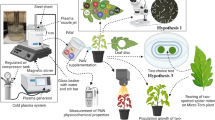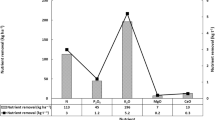Abstract
Colorado potato beetle (CPB), Leptinotarsa decemlineata (Say), is the most destructive pest of potato crops and the chemical composition of potato leaves plays an important role in CPB growth and development. Sugars and amino acids can promote CPB development by increasing feeding and flight behaviors, whereas glycoalkaloids are considered as plant defensive compounds to suppress CPB populations. In this study, the effects of nitrogen (N) fertilization on foliar sugar, amino acid, and glycoalkaloid concentrations of two potato cultivars (Russet Burbank and Goldrush) were investigated under controlled conditions. A pot experiment was carried out with five N rates (0, 60, 120, 180, and 240 kg N ha−1) in a randomized complete block design. The 3rd, 4th, and 5th leaves from the top of three randomly selected plants from a plot were collected at 61, 75, 89, and 103 days after planting for the analysis of sugars, glycoalkaloids, and amino acids. Nitrogen fertilization had no significant effect on glycoalkaloid concentrations, however, it quadratically increased foliar sugar and amino acid concentrations. Relatively low sugar and amino acid concentrations were observed at 180 kg N ha−1, suggesting that this N rate may be effective for CPB management. Significant differences in most of the foliar chemicals were observed between two cultivars, warranting further studies to investigate the leaf composition of different potato cultivars under field conditions and their effects on CPB behaviors.
Resumen
El escarabajo de la papa de Colorado (CPB), Leptinotarsa decemlineata (Say), es la plaga mas destructiva de los cultivos de papa, y la composición química de las hojas de la papa juega un papel importante en el crecimiento y desarrollo del CPB. Azucares y aminoácidos pueden promover el desarrollo del CPB mediante el incremento de comportamientos de alimentación y vuelo, mientras que los glicoalcaloides se consideran como compuestos de defensa de la planta para suprimir las poblaciones de CPB. En este estudio, se investigaron, bajo condiciones controladas, los efectos de la fertilización nitrogenada sobre las concentraciones del azúcar foliar, aminoácidos y glicoalcaloides, de dos variedades de papa (Russet Burbank y Goldrush). Un exprimento en macetas se llevó a cabo con cinco niveles de N (0, 60, 120, 180, y 240 kg N ha−1) en un diseño de bloques completamente al azar. Se colectaron la 3ª, 4ª, y 5ª hoja desde el ápice de tres plantas seleccionadas al azar de un lote a los 61, 75, 89, y 103 días después de la siembra para el análisis de azucares, glicoalcaloides y aminoácidos. La fertilización de nitrógeno no tuvo efecto significativo en las concentraciones de los glicoalcaloides, no obstante, incrementó cuadráticamente las concentraciones del azúcar foliar y de aminoácidos. Se observaron relativamente bajas concentraciones de azúcar y aminoácidos a 180 kg N ha−1 lo cual sugiere que este nivel de N pudiera ser efectivo para el manejo del CPB. Se observaron diferencias significativas en la mayoría de los compuestos químicos entre las dos variedades, lo que garantiza estudios posteriores para investigar la composición de la hoja de las diferentes variedades de papa bajo condiciones de campo y sus efectos en los comportamientos del CPB.




Similar content being viewed by others
Abbreviations
- GABA:
-
γ-aminobutyric acid
- Ala:
-
alanine
- Pro:
-
proline
- Ser:
-
serine
- Val:
-
valine
- Ile:
-
isoleucine
- Leu:
-
leucine
- Phe:
-
phenylalanine
- Tyr:
-
tyrosine
References
Alyokhin, A. 2009. Colorado potato beetle management on potatoes: Current challenges and future prospects. Fruit, Vegetable and Cereal Science and Biotechnology 3: 10–19.
Alyokhin, A., M. Baker, D. Mota-Sanchez, G. Dively, and E. Grafius. 2008. Colorado potato beetle resistance to insecticides. American Journal of Potato Research 85: 395–413.
Alyokhin, A., D. Mota-Sanchez, M. Baker, W.E. Snyder, S. Menasha, M. Whalon, G. Dively, and W.F. Moarsi. 2015. The red queen in a potato field: Integrated pest management versus chemical dependency in Colorado potato beetle control. Pest Management Science 71: 343–356.
Barnaby, J.Y., D. Fleisher, V. Reddy, and R. Sicher. 2015. Combined effects of CO2 enrichment, diurnal light levels and water stress on foliar metabolites of potato plants grown in naturally sunlit controlled environment chambers. Physiologia Plantarum 153: 243–252.
Boiteau, G., D.H. Lynch, and R.C. Martin. 2008. Influence of fertilization on the Colorado potato beetle, Leptinotarsa decemlineata, in organic potato production. Environmental Entomology 37: 575–585.
Braun, H., P.C.R. Fontes, T.P. da Silva, F.L. Finger, P.R. Cecon, and A.P.S. Ferreira. 2016. Carbohydrates concentration in leaves of potato plants affected by nitrogen fertilization rates. Revista Ceres 63: 241–248.
Cambouris, A.N., M.St. Luce, B.J. Zebarth, N. Ziadi, C.A. Grant, and I. Perron. 2016. Potato response to nitrogen sources and rates in an irrigated sandy soil. Agronomy Journal 108: 391–401.
CRAAQ. 2010. Centre de Référence en Agriculture et Agroalimentaire du Québec. Guide de Référence en Fertilisation, 2ndedition. Québec: CRAAQ.
Domek, J.M., W.W. Cantelo, R.M. Wagner, B.W. Li, and N.J. Miller-Ihli. 1995. Nutritional composition of potato foliage. Journal of Agricultural and Food Chemistry 43 (6): 1512–1515.
Evans, J.R., and V.C. Clarke. 2019. The nitrogen cost of photosynthesis. Journal of Experimental Botany 70: 7–15.
Ferro, D.N., J.A. Logan, R.H. Voss, and J.S. Elkinton. 1985. Colorado potato beetle (Coleoptera: Chrysomelidae) temperature-dependent growth and feeding rates. Environmental Entomology 14: 343–348.
Friedman, M., and C.E. Levin. 2009. Analysis and biological activities of potato glycoalkaloids, calystegine alkaloids, phenolic compounds, and anthocyanins. In Advances in potato chemistry and technology, Singh, J., and L. Kaur. Eds; Publisher: Academic Press, San Diego, CA, USA, pp. 127–161.
Huang, T., G. Jander, and M. de Vos. 2011. Non-protein amino acids in plant defense against insect herbivores: Representative cases and opportunities for further functional analysis. Phytochemistry 72: 1531–1537.
Khelifi, M., C. Laguë, and Y. de Ladurantaye. 2007. Physical control of Colorado potato beetle: A review. Applied Engineering in Agriculture 23: 557–569.
Lafta, A.M., and J.H. Lorenzen. 2000. Influence of high temperature and reduced irradiance on glycoalkaloid levels in potato leaves. Journal of the American Society for Horticultural Science 125: 563–566.
Leonel, M., E.L. do Carmo, A.M. Fernandes, R.P. Soratto, J.A.M. Ebúrneo, É.L. Garcia, and T.P.R. Dos Santos. 2017. Chemical composition of potato tubers: The effect of cultivars and growth conditions. Journal of Food Science and Technology 54: 2372–2378.
Liu, F., C.R. Jensen, A. Shahanzari, M.N. Andersen, and S.E. Jacobsen. 2005. ABA regulated stomatal control and photosynthetic water use efficiency of potato (Solanum tuberosum L.) during progressive soil drying. Plant Science 168: 831–836.
Lynch, D.H., M. Sharifi, A. Hammermeister, and D. Burton. 2012. Nitrogen management in organic potato production. In Sustainable Potato Production: Global Case Studies, He, Q., R. Larkin, and W. Honeycutt. Eds; Springer, Dordrecht, pp. 209–231.
Mekapogu, M., H.B. Sohn, S.J. Kim, Y.Y. Lee, H.M. Park, Y.I. Jin, S.Y. Hong, J.T. Suh, K. Kweon, J.C. Jeong, O.K. Kwon, and Y.H. Kim. 2016. Effect of light quality on the expression of glycoalkaloid biosynthetic genes contributing to steroidal glycoalkaloid accumulation in potato. American Journal of Potato Research 93: 264–277.
Mitchell, B.K., and G.D. Harrison. 1984. Characterization of galeal chemosensilla in the adult Colorado beetle, Leptinotarsa decemlineata. Physiological Entomology 9: 49–56.
Mitchell, B.K., and L.M. Schoonhoven. 1974. Taste receptors in Colorado beetle larvae. Journal of Insect Physiology 20 (9): 1787–1789 1791–1793.
Mondy, N.I., and C.B. Munshi. 1990. Effect of nitrogen fertilization on glycoalkaloid and nitrate content of potatoes. Journal of Agricultural and Food Chemistry 38: 565–567.
Nassar, A.M., K. Sabally, S. Kubow, Y.N. Leclerc, and D.J. Donnelly. 2012. Some Canadian-grown potato cultivars contribute to a substantial content of essential dietary minerals. Journal of Agricultural and Food Chemistry 60: 4688–4696.
Papathanasiou, F., S.H. Mitchell, S. Watson, and B.M.R. Harvey. 1999. Effect of environmental stress during tuber development on accumulation of glycoalkaloids in potato (Solanum tuberosum L). Journal of the Science of Food and Agriculture 79: 1183–1189.
Sen, A., and B.K. Mitchell. 1987. Ultrastructure of the galeal sensory complex in adults of the Colorado potato beetle, Leptinotarsa decemlineata. Physiological Entomology 12: 81–90.
Simon A.M., H. Mwale, B. Chimzinga, K. Longwe, and P. Muhota. 2017. In vitro potato (Solanun tuberosum L.) growth under different orientation and light/dark exposure conditions. African Journal of Biotechnology 16: 1784–1790.
Vos, J., and H. Biemond. 1992. Effects of nitrogen on the development and growth of the potato plant. 1. Leaf appearance, expansion growth, life spans of leaves and stem branching. Annals of Botany 70: 27–35.
Vos, J., and P.E.L. van der Putten. 1998. Effect of nitrogen supply on leaf growth, leaf nitrogen economy and photosynthetic capacity in potato. Field Crops Research 59: 63–72.
Weber, D.C., and D.N. Ferro. 1994. Colorado potato beetle: Diverse life history poses challenge to management. In Advances in potato pest biology and management: Global Perspectives on Biology and Management, Giordanengo, P., C. Vincent, and A. Alyokhin. Eds; Publisher: Academic Press, Waltham, MA, USA, pp. 54–70.
Weeda, E., C.A.D. de Kort, and A.M.Th. Beenakkers. 1979. Fuels for energy metabolism in the Colorado potato beetle, Leptinotarsa decemlineata say. Journal of Insect Physiology 25: 951–955.
Wen, G., A.N. Cambouris, A. Bertrand, H. Li, and M. Khelifi. 2019a. Nitrogen fertilization effects on the leaf chemical concentrations in russet Burbank potato. Field Crops Research 232: 40–48.
Wen, G., M. Khelifi, A.N. Cambouris, and N. Ziadi. 2019b. Responses of the Colorado potato beetle (Coleoptera: Chrysomelidae) to the chemical composition of potato plant foliage. Potato Research 62: 157–173.
Wright, R.J. 1984. Evaluation of crop rotation for control of Colorado potato beetles (Coleoptera: Chrysomelidae) in commercial potato fields on Long Island. Journal of Economic Entomology 77: 1254–1259.
Acknowledgments
This study was financially supported by the Growing Forward Program of Agriculture and Agri-Food Canada (AAFC). The authors would like to thank Haixiao Li from Nankai University and Sandra Delaney from AAFC’s Quebec Research and Development Centre for their assistance with sample collection and laboratory analysis. The first author acknowledges the assistance received from “Le Fonds de recherche du Québec – Nature et technologies (FRQNT)” in the form of a Ph.D. scholarship during his studies at Université Laval.
Author information
Authors and Affiliations
Corresponding author
Additional information
Core ideas:
• Nitrogen fertilization significantly increased foliar sugar and amino acid concentrations, but not glycoalkaloid concentrations.
• Significant differences in the concentrations of most foliar chemicals were observed between potato cv. Goldrush and Russet Burbank.
• Leaf sugar and glycoalkaloid concentrations increased, while amino acid concentrations significantly decreased with increasing sampling dates.
• Under a rate of 180 kg N ha-1, lower concentrations of total sugar and amino acid were observed compared with those at other N rates, suggesting that this N rate could be selected for Colorado potato beetle control.
Rights and permissions
About this article
Cite this article
Wen, G., Cambouris, A.N., Ziadi, N. et al. Effects of Nitrogen Fertilization on the Leaf Chemical Composition of Two Potato Cultivars under Controlled Conditions. Am. J. Potato Res. 97, 175–184 (2020). https://doi.org/10.1007/s12230-020-09765-5
Published:
Issue Date:
DOI: https://doi.org/10.1007/s12230-020-09765-5




